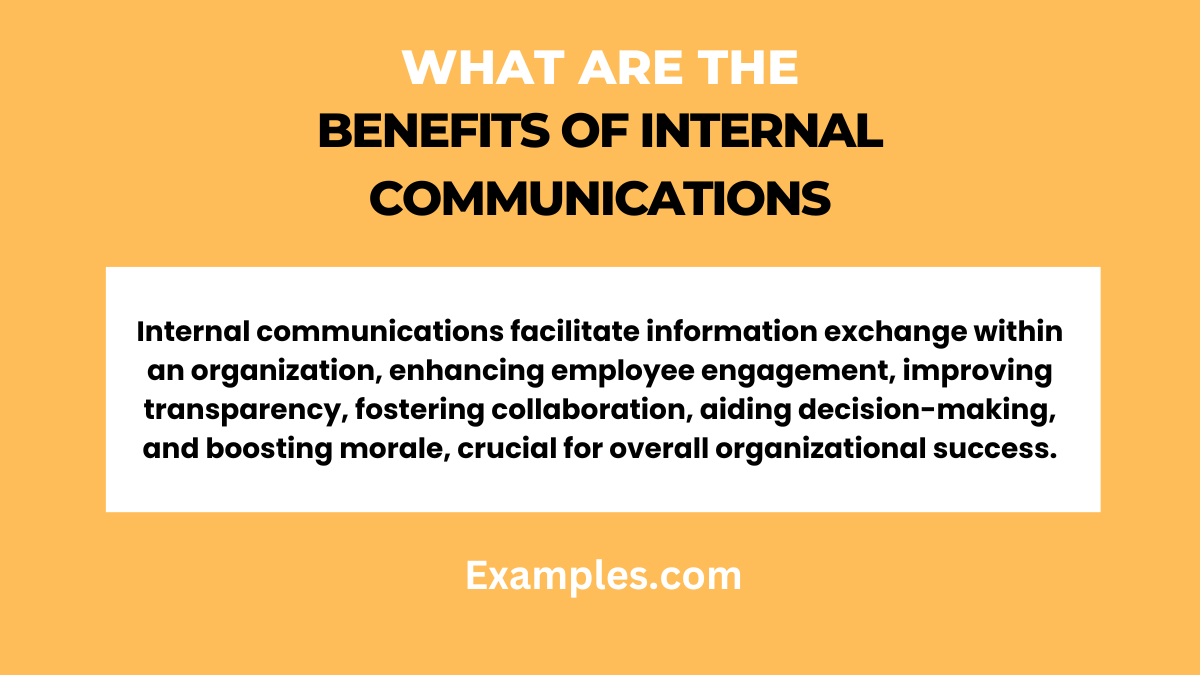Benefits & Uses of Internal Communication
In this comprehensive guide, we delve into the multifaceted world of internal communication. We’ll explore various internal communication examples to illustrate its pivotal role in organizations. From enhancing employee engagement to streamlining operations, effective internal communication is a key driver of success. Understanding its types, functions, and best practices not only clarifies its importance but also reveals how it can transform workplace dynamics, making this guide indispensable for professionals aiming to leverage internal communication’s full potential.
What are the Benefits of Internal Communications? – Definition

Internal communications refer to the processes and tools used for effective information sharing within an organization. At its core, it involves strategies and methods that facilitate a smooth flow of information among employees, departments, and management levels. This communication can take various forms, from formal memos and meetings to informal chats and digital platforms. The key benefits of efficient internal communications are numerous, including enhanced employee engagement, better information dissemination, and improved organizational cohesion. By understanding the importance of internal communication, organizations can foster a more collaborative, informed, and productive workplace environment.
10 Benefits of Effective Internal Communications
Effective internal communications are essential for the success and vitality of any organization. They shape the way information is disseminated, collaborations are nurtured, and how a company’s culture is preserved. This guide highlights the top ten benefits of effective internal communications, emphasizing their wide-ranging impacts.

Enhanced Employee Engagement
Effective internal communications significantly boost employee engagement, a key aspect of internal communication in the workplace. When employees are well-informed and included in the communication loop, they feel more connected to the organization’s goals and values. This connection fosters a sense of ownership and responsibility, leading to higher motivation, reduced turnover, and increased job satisfaction. Engaged employees are more likely to contribute ideas and feedback, which can drive innovation and improvement within the organization.
Improved Organizational Transparency
Transparency within an organization, a crucial element of internal communication in business, builds trust and credibility. Clear and open communication channels ensure that employees are aware of organizational decisions, changes, and the reasons behind them. This transparency not only builds trust but also dispels rumors and misinformation, creating a more honest and straightforward organizational climate.
Increased Productivity and Efficiency
Efficient communication channels, often facilitated by internal communication platforms/tools, streamline workflows, reducing time wasted on miscommunications or seeking information. When employees have clear instructions and access to the information they need, they can perform their tasks more efficiently. This heightened efficiency leads to better time management and productivity, positively impacting the organization’s bottom line.
Better Crisis Management
In crisis situations, effective internal communication, a crucial aspect of internal communication in organizations, is vital. It ensures that employees receive accurate and timely information, enabling them to respond appropriately. Whether it’s a natural disaster, a public relations issue, or an internal problem, well-structured communication helps in mitigating panic, maintaining order, and providing clear instructions on how to proceed.
Enhanced Collaboration and Teamwork
Good internal communication fosters a culture of collaboration. When communication barriers are removed, team members can easily share ideas, provide feedback, and work together towards common goals. This improved collaboration is essential for innovation, problem-solving, and achieving business objectives, as it harnesses the diverse skills and perspectives of various team members.
Informed Decision-Making
Informed employees contribute more effectively to the decision-making process. When internal communications are effective, employees at all levels have access to the information they need. This inclusive approach to information sharing empowers employees to make decisions that are aligned with the organization’s objectives and informed by a comprehensive understanding of the business.
Stronger Company Culture
The company culture is significantly influenced by internal communication. A culture where open, honest, and respectful communication is the norm leads to a more positive and inclusive work environment. This kind of culture not only attracts quality talent but also retains them, as employees are more likely to stay in a workplace where they feel valued and heard.
Effective Change Management
Change is a constant in the business world, and effective internal communication is critical in managing it. Whether it’s a change in leadership, strategy, or operations, clear and consistent communication helps in aligning employees with the new direction. It ensures that transitions are smooth and that employees understand and support the changes being implemented.
Conflict Resolution
Effective communication is key in resolving conflicts in the workplace. It provides a platform for open discussion and problem-solving, allowing employees to express their concerns and viewpoints constructively. This open dialogue is essential for maintaining harmony within the team and ensuring that conflicts are resolved in a manner that strengthens relationships rather than weakening them.
Improved Employee Morale and Job Satisfaction
Employees who feel listened to and valued through effective communication channels are likely to experience higher job satisfaction and morale. This positive impact on morale goes a long way in creating a workplace where employees feel motivated and happy, which in turn reduces absenteeism and improves overall productivity.
In conclusion, the role of effective internal communications in an organization cannot be overstated. From enhancing employee engagement to facilitating better crisis management, the benefits are both far-reaching and essential for the sustainable success of any organization. By prioritizing effective communication strategies, businesses can create a more engaged, informed, and collaborative workforce, leveraging the full potential of internal communication in the workplace.
What is the Use of Internal and External Communication?
Understanding the use of internal and external communication is crucial for any organization aiming to thrive in today’s fast-paced business environment. While these two forms of communication serve different purposes, they are both integral to the overall success and efficiency of an organization.
Internal Communication
Internal communication refers to the exchange of information and ideas within an organization. It includes various methods and channels, such as meetings, emails, internal newsletters, and digital communication platforms. The primary uses of internal communication are:
- Fostering Collaboration and Teamwork: It encourages a collaborative culture, facilitating internal communication between departments, teams, and individuals.
- Enhancing Employee Engagement: By keeping employees informed and involved, internal communication in the workplace boosts engagement and morale.
- Facilitating Information Dissemination: Effective internal communication ensures that important information, such as company policies and updates, reaches all employees timely and accurately.
- Supporting Employee Development: Through feedback and open dialogue, it contributes to the professional growth and development of employees.
External Communication
External communication, on the other hand, involves the sharing of information between an organization and external entities like clients, investors, and the public. Its uses include:
- Building Brand Image and Reputation: Through marketing, public relations, and customer interactions, external communication shapes how the organization is perceived externally.
- Customer Engagement and Satisfaction: It plays a crucial role in customer service and support, directly impacting customer satisfaction and loyalty.
- Investor and Stakeholder Relations: Regular and transparent communication with stakeholders and investors is key for maintaining trust and support.
The Interplay of Internal and External Communication
The interplay between internal and external communication is vital. For instance, internal communication in public relations involves preparing employees to represent the company positively to the outside world. Similarly, internal feedback and insights can shape external communication strategies, ensuring they align with the company’s values and goals.
In summary, internal and external communications serve distinct yet complementary roles. Internal communication is about building a strong, cohesive, and informed internal environment, while external communication focuses on establishing and maintaining a positive image and relationship with the outside world. Both forms of communication are essential for an organization’s success, influencing everything from internal communication in business dynamics to how a company is perceived in the public eye.
In conclusion, the benefits and uses of internal communication are pivotal in shaping an organization’s success. From enhancing employee engagement to building a strong external brand image, effective communication strategies are key. This guide provides valuable insights and tips on harnessing the power of both internal and external communications, essential for any organization aiming for excellence and efficiency in today’s dynamic business environment.



